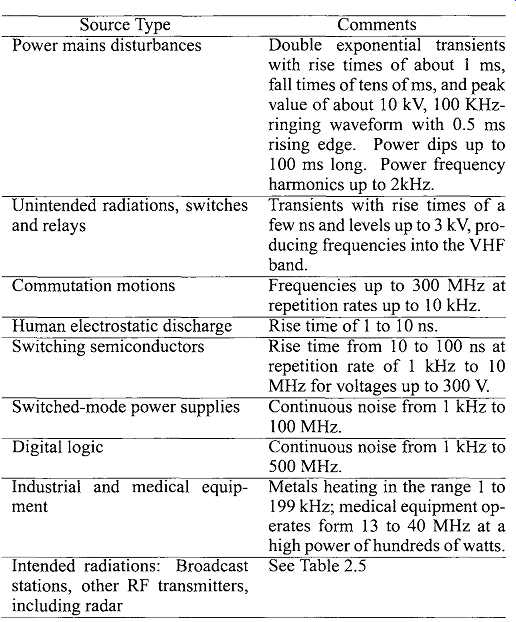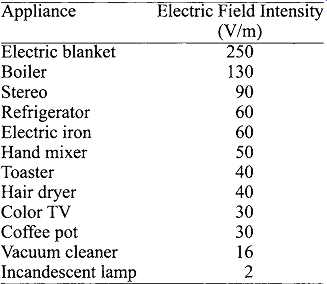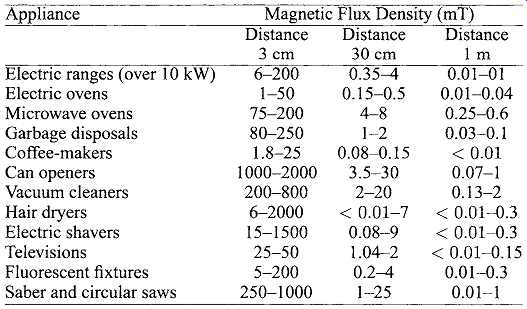AMAZON multi-meters discounts AMAZON oscilloscope discounts
1. INTRODUCTION
In this section we describe a variety of possible EMI sources (or noise sources) existing in the electromagnetic environment; these sources can potentially degrade the performance of an electronic system operating in their vicinity. It’s difficult to classify the noise sources because of their variety. However, on the basis of their origin, they can be classified into two broad categories: as natural noise and as man-made noise. The literature on both types of noise is vast. Brief discussions of such noises in the context of EMC are given in 11-41, and more detailed discussions are given in [5-10]. In the following sections we present listings of some noise sources selected on the basis of their relevance to EMC. Where appropriate, brief comments and discussions are given about their general nature and behavior.
Atmospherics (noise from lightning around the world)
Nearby and medium distant
2. NATURAL NOISE
Principal natural phenomena that can cause disturbances for an electronic device are listed in TBL. 1.
Atmospherics are caused by electric discharge in the atmosphere; strong sources of atmospheric noise are lightning and electrostatic discharge (ESD) . ESD is a natural phenomenon in which accumulated static charges are discharged and in turn cause EMI [3]. We will discuss ESD in a later section.
=====

TBL. 1 Classification of Natural EMI Sources lightning
Cosmic/galactic radio noise
Solar noise (whistles. solar- Electrostatic Discharge (ESD) disturbed and quiet radio noise)
Terrestrial / Extraterrestrial
======
The Milky Way galaxy and the sun are the primary sources of extraterrestrial or cosmic radio noise; these sources can be of two types: spatially extensive and spatially discrete. Spatially extensive sources emit broadband noise while emissions from the discrete sources may be either narrowband or broadband [9].
3. MAN-MADE NOISE
Man-made noise sources are so varied that it’s difficult to list them extensively.
Comprehensive data on the amplitude and statistics of man-made radio noise sources are given in [7-10] TBL. 2 gives a list of man-made sources due to different causes [5]. Man-made noise is generally broadband in nature and can arise from many sources as indicated in TBL. 2.
4. CW AND TRANSIENT SOURCES
For analytical purposes and for performing design of electronic systems for EMC, it’s convenient to classify the EMI sources on the basis of the time domain behavior of their emissions into continuous wave (CW) and transient sources. TBL. 3 gives a listing of various sources on this basis [5]. Important characteristics of some typical CW and transient EMI sources are discussed in [5], and are given in TBL. 4.
=======
TBL. 2 Classification of Man-made EMI Sources
EMI sources due to the power network and its equipment: Switching operations Power faults Rectifiers Electric motors Contractors Static and rotary connectors EMI sources due to industrial and commercial equipment: Arc furnaces Fluorescent lamps Induction furnaces Neon displaces Air conditioning Medical equipment EMI sources due to machines and tools: Workshop machines Rotary saws Rolling mills Compressors Cotton mills Ultrasonic cleaners Welders EMI sources due to communication systems: Radio broadcast stations Citizens-band TV stations Mobile telephones Radar Remote control door-opening transmitters EMI sources due to consumer devices: Microwave ovens Vacuum cleaners Refrigerator freezers Hair dryers Thermostats Shavers Mixers Light dimmers Washing machines Personal computers
=======
TBL. 3 Continuous and Transient EMI Sources
Sources of Continuous EMI Sources of Transient EMI / Sources (Sources with Fixed Frequencies)
Broadcast stations; Lightning; High-power radar; Nuclear EMP; Electric motor noise; Powerline faults (sparking)
Fixed and mobile communications Switches and relays Computers, visual display units, Electric welding equipment pointers High-repetition ignition noise AC/multiphase power rectifiers Solar and cosmic radio noise with a Large Frequency Spectrum Low-repetition ignition noise Electric train power pickup arcing Human electromotor discharge
=======

TBL. 4 Frequencies and Noise Levels from Typical Interference Sources
Source Type Comments Power mains disturbances Double exponential transients with rise times of about 1 ms, fall times of tens of ms, and peak value of about 10 kV, 100 KHz- ringing waveform with 0.5 ms rising edge. Power dips up to 100 ms long. Power frequency harmonics up to 2kHz.
Transients with rise times of a few ns and levels up to 3 kV, producing frequencies into the VHF band.
Frequencies up to 300 MHz at repetition rates up to 10 kHz.
Rise time of 1 to 10 ns.
Rise time from 10 to 100 ns at repetition rate of 1 kHz to 10 MHz for voltages up to 300 V. Switched-mode power supplies Continuous noise from 1 kHz to 100 MHz.
Digital logic Continuous noise from 1 kHz to 500 MHz.
Industrial and medical equip
Metals heating in the range 1 to ment 199 kHz; medical equipment operates form 13 to 40 MHz at a high power of hundreds of watts.
Unintended radiations, switches and relays; Commutation motions; Human electrostatic discharge; Switching semiconductors; Intended radiations: Broadcast See TBL. 5 stations, other RF transmitters, including radar
=======
TBL. 5 Effective Radiated Power and Field Strength from Authorized Services
Service Frequency Effective Usual Range Estimated Range Radiated of Separation Range of Power Distances Field Strength (MHz) (dBW) (km) (V/m)
Low frequency (LF) Communication and Navigation aids AM broadcast HF amateur HF communications Citizens' band Fixed and mobile Television (VHF) FM broadcast Television (UHF) Radar communications
=======
5. CHARACTERISTIC PARAMETERS OF AUTHORIZED RADIATORS
Radio, television, and radar are authorized sources of radiation. They can also be potential sources of interference to certain electronic devices not intended to receive their signal but operating in their vicinity. TBL. 5 gives the effective radiated power, estimated field strength, frequency, and so forth, for a few selected authorized systems that may be found useful to estimate their interference effect on the performance of certain electronic devices operating in their vicinity.
6. NOISE EMISSION INTENSITY
Frequently an electronic device is vulnerable to the EMI effects caused by manmade noise sources in its vicinity if proper EMC considerations are not given during the design of the device. Noise emission intensities of man-made noise sources vary with frequency. Despite the wide variations of frequency and intensity of these emissions, an approximate ranking of intensity exists for these sources, and it can be used as a guide for estimating their potential impact. The following list gives the ranking of unintentional man-made noise sources:
Unintentional Man-made Noise Sources
1. Automotive Sources
+Ignition circuitry
+Alternators, generators, and electric motors
+Buzzers, switches, regulators, and horns
2. Power Transport and Generating Facilities
+Distribution lines
+ac Transformer substations
+dc Rectifier stations
+Generating stations
3. Industrial Equipment
+RF stabilized arc welders
+Electric discharge machines
+Induction heating equipment
+RF soldering machines
+Dielectric welder and cutting machines
+Dielectric and plastic preheater
+Wood gluing equipment
+Silicon control rectifiers (SCR)
+Electric motors and inverters
+Circuit breakers
+Circuit switches
+Microwave heaters
+Electric calculators and office machines
+Cargo-loading cranes
4. Consumer Products
+Appliance motors
+Fluorescent, sodium vapor, and mercury vapor lights
+Vibrators
+Citizen-band AM transmitter spurious emissions
+Electric door openers
+Television local oscillator radiation
5. Lighting systems
+Neon, mercury, argon, and sodium
+Vapor lights
+Fluorescent light fixtures
6. Medical Equipment
+Diathermy
7. Electric Trains and Buses
+DC-drive motors
+Pantograph and third-rail contacts
===

TBL. 6 Intensity of Electric Field Levels in a Typical American Home: Location
Laundry room Dining room Bathroom, Kitchen, Bedroom, Living room, Hallway Electric
field intensity (V/m)
===

TBL. 7 Appliances Electric Field Intensity: Levels at 30 cm from 1 15
V Home Electrical Appliance Electric Field Intensity Electric blanket
250 Boiler 130 Stereo 90 Refrigerator 60 Electric iron 60 Hand mixer 50
Toaster 40 Hair dryer 40 Color TV 30 Coffee pot 30 Vacuum cleaner 16 Incandescent
lamp 2 (V/m)
===

TBL. 8 Appliances Magnetic Flux Densities Measured at Different Distances
from 115/200 V: Appliance Magnetic Flux Density (mT) Distance, Distance;
Distance 3 cm 30 cm lm Electric ranges (over 10 kW) 6-200 0.354 0.01-01
Electric ovens Microwave ovens Garbage disposals Coffee-makers Can openers
Vacuum cleaners Hair dryers Electric shavers Televisions Fluorescent
fixtures Saber and circular saws
===
7. HOME ENVIRONMENT
A typical American home environment is filled with electrical and magnetic emissions from a variety of electrical, electromechanical and electronic systems that are in use in the home. Brief discussion of such noises and how to model them electrically for analysis are given in [3]. Electromagnetic fields originating from various sources in the home have been probed and reported in [12-14].
Intensities of electric fields in various rooms of a typical American home are given in TBL. 6 and the measured electric field intensity levels at 30 cm from 115 V home electrical appliances are given in TBL. 7. Magnetic flux densities measured at different distances from various 115 V appliances are given in TBL. 8.
8. DISCUSSION OF NOISE SOURCES
Comprehensive data on the amplitude and time statistics of man-made radio noise are given in [10]. A brief description of such noises is given in [4], while detailed treatment of the major sources of man-made noise and their measurement and physical description are given in [9]. Automobile ignition systems and power distribution and transmission lines are the two unintentional noise sources of primary importance for which ample data exist [9]. The causes of radiated EMI noise arising from vehicular ignition systems are known to be gap discharges produced by the distributor and breaker points and radiation from various leads, each enhanced by the presence of circuit and engine cavity resonance [9].
Power line EMI noise signals are produced by one or more of the following causes: (1) gap discharge or insulating film breakdown, (2) high-voltage corona discharge from conducting points with high potential gradient, and (3) line radiation of interference signal injected into the transmission system by equipment loads. Also open wire lines and electric power transmission lines can easily pick up EM noise from lightning and thunderstorms [3,5]. Main power supply lines in industrial and home environments also carry transients, resulting from switches, circuit-breakers, heavy load switching, and the like [3]. These disturbances are strong enough to impair the operation of computers and many IT products (especially digital). The source of atmospheric radio noise is lightning discharges produced during thunderstorms occurring worldwide [5,6]; a short discussion is given in [9].
9. SUBJECT MATTER OF THE GUIDE
It’s apparent from the discussions given so far that knowledge of basic properties of electromagnetic fields and waves is necessary for the understanding of EMI effects and for the design of electronic systems from the viewpoint of EMC. The present guide, at first, discusses the fundamentals of electromagnetics and selected topics of electromagnetic fields and waves deemed to be a necessary minimum for an understanding of various phenomena associated with EMC. Then selected topics in EMC are discussed.
REFERENCES:
1. C. R. Paul, Introduction to Electromagnetic Compatibly, Wiley, New York, 1992
2. H. W. Ott, Noise Reduction Techniques in Electronic Systems, 2nd ed., Wiley, New York,
3. V. P. Kodali, Engineering Electromagnetic Compatibility, IEEE Press, New York, 1996.
4. A. A. Smith, Jr., Radio Frequency Principles and Applications, IEEE Press, The Institute
5. M. A. Uman, Understanding Lightning, Bek Publications, Carnegie, PA, 197 1.
6. J. Molan, The Physics of lightning, English Universities Press, London, 1963.
7. E. N. Skomal and A. A. Smith Jr., Measuring the Radio Frequency Environment, Van 1988. of Electrical and Electronics Engineers, New York, 1998. Nostrand Reinhold, New York, 1977.
8. D. A. Morgan, A Hand guide for EMC Testing and Measurement Series 8, Peter Peregrinus,
9. E. N. Skomal, Man-made Radio Noise, Van Nostrand Reinhold, New York, 1978. London, 1994.
10. A. D. Spaulding and R. T. Disney, Man-made Radio Noise, Part I, Estimates for Business, Residential, and Rural Areas, US Dept. of Commerce, Office of Telecommunications, Institute for Telecommunications Sciences, OT Report 74-38, June 1974. Models, Wiley, New York, 1997.
11. F. M. Tesche, M. V. ianuz and T. Karlsson, EMC Analysis Methods and Computational
12. F. S. Barnes, "Typical electric and magnetic field exposure at power line frequencies and their coupling to biological systems," in Biological Effects of Environmental Electromagnetic Fields, ed. M. Bland, ACS Guides, Washington DC, 1995.
13. EPRI Project 19955-07, Final Report TR100580, June 1992.
14. ITT Research Institute Technical Report E06549-3
Prev. ------ Next